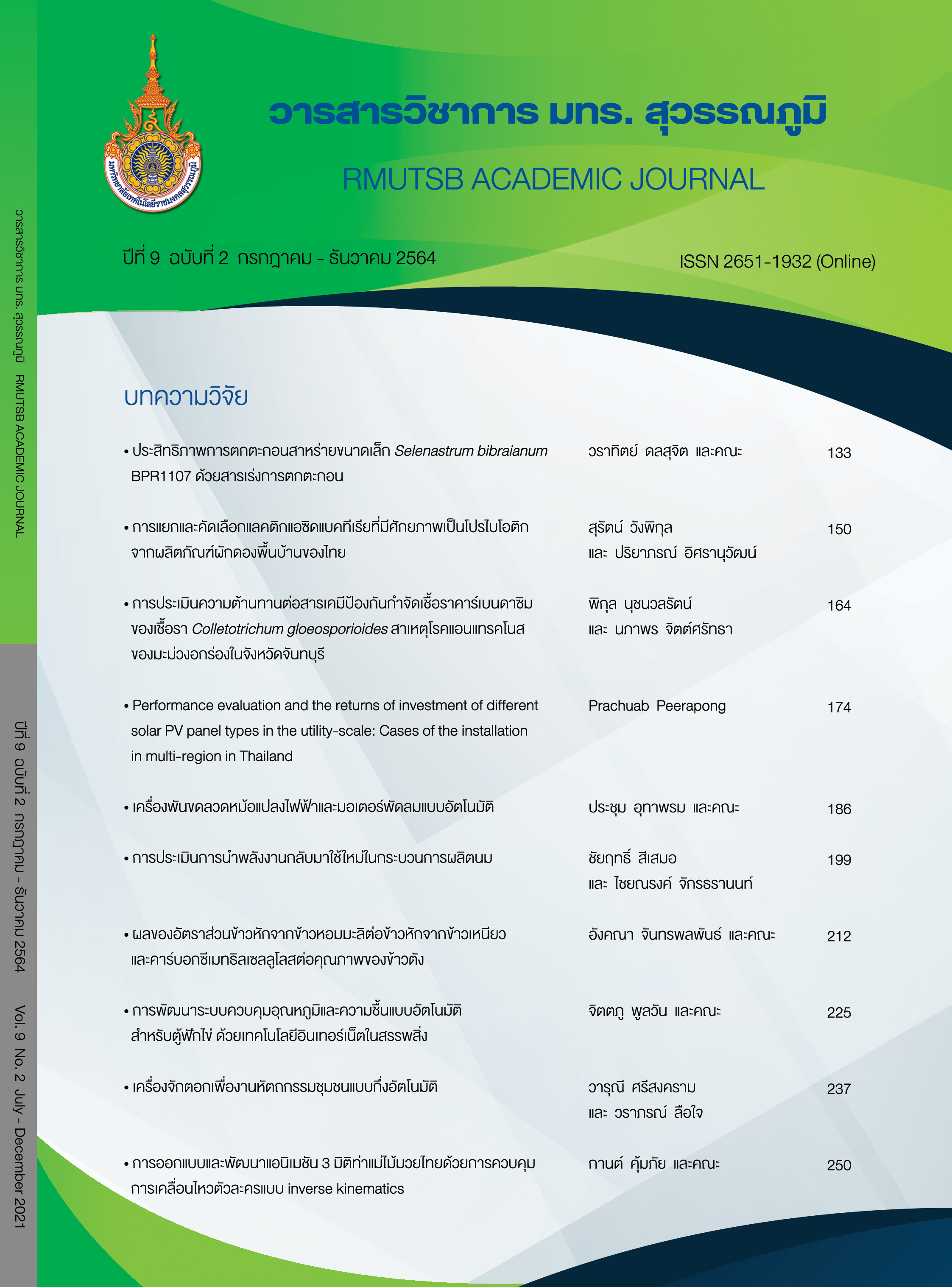Energy recovery assessment in dairy production process
Main Article Content
Abstract
This research aimed to study utilizing the energy from regasifying the liquid nitrogen in a diary factory for reducing the energy consumption in a refrigeration system. In the study, the daily usage of liquid nitrogen, such as volume flow rate, pressure, and temperature, was applied for evaluating the heat of vaporization of liquid nitrogen. Moreover, cooling load of decreasing the temperature of milk to 8 oC before transporting to distributors was computed. It was found from analysis that at the liquid nitrogen 100 m3/h and pressure 7 bar, the heat of vaporization provided the refrigeration capacity of 13.35 kW. This study proposed three methods of energy saving in refrigeration system with various heat exchangers: (1) Decrease of temperature of chilled water before returning into the water chiller, resulting in reducing the chiller power of 7.39 kW or saving of 815.85 Baht/day. (2) Decrease of the temperature of chilled water before supplying to manufacturing process. Therefore, the chilled-water temperature leaving from the chiller can be set higher. This leads chiller power to reduce of 0.68 kW or saving of 75.07 Baht/day. (3) Decrease the temperature of milk to 8 oC with ice thermal storage. This provides the maximum energy saving. It can save the energy of 792.20 kWh/day or 2,851.92 Baht/day.
Article Details
Published manuscript are the rights of their original owners and RMUTSB Academic Journal. The manuscript content belongs to the authors' idea, it is not the opinion of the journal's committee and not the responsibility of Rajamangala University of Technology Suvarnabhumi
References
Agarwal, R., Rainey, T. J., Rahman, S. M. A., Steinberg, T., Perrons, R. K., & Brown, R. J. (2017). LNG Regasification terminals: The role of geography and meteorology on technology choices. Energies, 10(1), 2152.
Coles, R., & Kirwan, M. (2007). Food and beverage packaging technology. West Sussex, UK: John Wiley & Sons.
Dorgan, C. E., & Elleson, J. S. (1993). Design guide for cool thermal storage. Georgia: ASHRAE.
Dorosz, P., Wojcieszak, P., & Malecha, Z. (2018). Exergetic analysis, optimization and comparison of LNG cold exergy recovery systems for transportation. Entropy, 20(1), 59.
La Rocca, V. (2010). Cold recovery during regasification of LNG part one: Cold utilization far from the regasification facility. Energy, 35(5), 2049-2058.
La Rocca, V. (2011). Cold recovery during regasification of LNG part two: Applications in an agro food industry and a hypermarket. Energy, 36(8), 4897-4908.
Marshall, N. (1976). Gas encyclopedia. New York: Elsevier.
Mongibello, L., Bianco, N., Caliano, M., & Graditi, G. (2017). A new approach for the dimensioning of an air conditioning system with cold thermal energy storage. Energy Procedia, 105, 4295-4304.
Munsch-Alatossava, P., Gursoy, P., & Alatossava, T. (2010). Potential of nitrogen gas (N2) to control psychrotrophs and mesophiles in raw milk. Microbiological Research, 165(2), 122-132.
Rahdar, M. H., Emamzadeh, A., & Ataei, A. (2016). A comparative study on PCM and ice thermal energy storage tank for air-conditioning systems in office buildings. Applied Thermal Engineering, 96, 391-399.
Tan, H., Li, Y., Tuo, H., Zhou, M., & Tian, B. (2010). Experimental study on liquid/solid phase change for cold energy storage of Liquefied Natural Gas (LNG) refrigerated vehicle. Energy, 35(5), 1927-1935.
Yang, L., Villalobos, U., Akhmetov, B., Gil, A., Khor, J. O., Palacios, A., Li, Y., Ding, Y., Cabeza, L. F., Tan, W. L., & Romagnoli, A. (2021). A comprehensive review on sub-zero temperature cold thermal energy storage materials, technologies, and applications: State of the art and recent developments. Applied Energy, 188, 116555.
Wattana, S. (1996). A feasibility study on using the ice storage system for commercial buildings (Master’s thessis). Chulalongkorn University, Bangkok.
Wu, C., & Tsai, Y. (2015). Design of an ice thermal energy storage system for a building of hospitality. International Journal of Hospitality Management, 46, 46-54.


